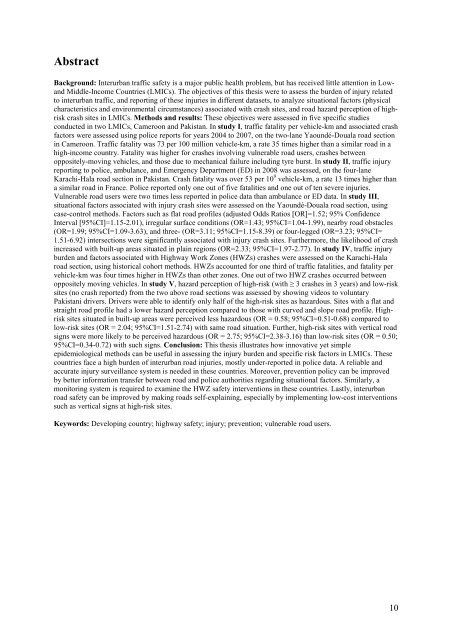thèse doctorat de l'université bordeaux 2 - ISPED-Enseignement à ...
thèse doctorat de l'université bordeaux 2 - ISPED-Enseignement à ...
thèse doctorat de l'université bordeaux 2 - ISPED-Enseignement à ...
You also want an ePaper? Increase the reach of your titles
YUMPU automatically turns print PDFs into web optimized ePapers that Google loves.
AbstractBackground: Interurban traffic safety is a major public health problem, but has received little attention in LowandMiddle-Income Countries (LMICs). The objectives of this thesis were to assess the bur<strong>de</strong>n of injury relatedto interurban traffic, and reporting of these injuries in different datasets, to analyze situational factors (physicalcharacteristics and environmental circumstances) associated with crash sites, and road hazard perception of highriskcrash sites in LMICs. Methods and results: These objectives were assessed in five specific studiesconducted in two LMICs, Cameroon and Pakistan. In study I, traffic fatality per vehicle-km and associated crashfactors were assessed using police reports for years 2004 to 2007, on the two-lane Yaoundé-Douala road sectionin Cameroon. Traffic fatality was 73 per 100 million vehicle-km, a rate 35 times higher than a similar road in ahigh-income country. Fatality was higher for crashes involving vulnerable road users, crashes betweenoppositely-moving vehicles, and those due to mechanical failure including tyre burst. In study II, traffic injuryreporting to police, ambulance, and Emergency Department (ED) in 2008 was assessed, on the four-laneKarachi-Hala road section in Pakistan. Crash fatality was over 53 per 10 9 vehicle-km, a rate 13 times higher thana similar road in France. Police reported only one out of five fatalities and one out of ten severe injuries.Vulnerable road users were two times less reported in police data than ambulance or ED data. In study III,situational factors associated with injury crash sites were assessed on the Yaoundé-Douala road section, usingcase-control methods. Factors such as flat road profiles (adjusted Odds Ratios [OR]=1.52; 95% Confi<strong>de</strong>nceInterval [95%CI]=1.15-2.01), irregular surface conditions (OR=1.43; 95%CI=1.04-1.99), nearby road obstacles(OR=1.99; 95%CI=1.09-3.63), and three- (OR=3.11; 95%CI=1.15-8.39) or four-legged (OR=3.23; 95%CI=1.51-6.92) intersections were significantly associated with injury crash sites. Furthermore, the likelihood of crashincreased with built-up areas situated in plain regions (OR=2.33; 95%CI=1.97-2.77). In study IV, traffic injurybur<strong>de</strong>n and factors associated with Highway Work Zones (HWZs) crashes were assessed on the Karachi-Halaroad section, using historical cohort methods. HWZs accounted for one third of traffic fatalities, and fatality pervehicle-km was four times higher in HWZs than other zones. One out of two HWZ crashes occurred betweenoppositely moving vehicles. In study V, hazard perception of high-risk (with ≥ 3 crashes in 3 years) and low-risksites (no crash reported) from the two above road sections was assessed by showing vi<strong>de</strong>os to voluntaryPakistani drivers. Drivers were able to i<strong>de</strong>ntify only half of the high-risk sites as hazardous. Sites with a flat andstraight road profile had a lower hazard perception compared to those with curved and slope road profile. Highrisksites situated in built-up areas were perceived less hazardous (OR = 0.58; 95%CI=0.51-0.68) compared tolow-risk sites (OR = 2.04; 95%CI=1.51-2.74) with same road situation. Further, high-risk sites with vertical roadsigns were more likely to be perceived hazardous (OR = 2.75; 95%CI=2.38-3.16) than low-risk sites (OR = 0.50;95%CI=0.34-0.72) with such signs. Conclusion: This thesis illustrates how innovative yet simpleepi<strong>de</strong>miological methods can be useful in assessing the injury bur<strong>de</strong>n and specific risk factors in LMICs. Thesecountries face a high bur<strong>de</strong>n of interurban road injuries, mostly un<strong>de</strong>r-reported in police data. A reliable andaccurate injury surveillance system is nee<strong>de</strong>d in these countries. Moreover, prevention policy can be improvedby better information transfer between road and police authorities regarding situational factors. Similarly, amonitoring system is required to examine the HWZ safety interventions in these countries. Lastly, interurbanroad safety can be improved by making roads self-explaining, especially by implementing low-cost interventionssuch as vertical signs at high-risk sites.Keywords: Developing country; highway safety; injury; prevention; vulnerable road users.10
















